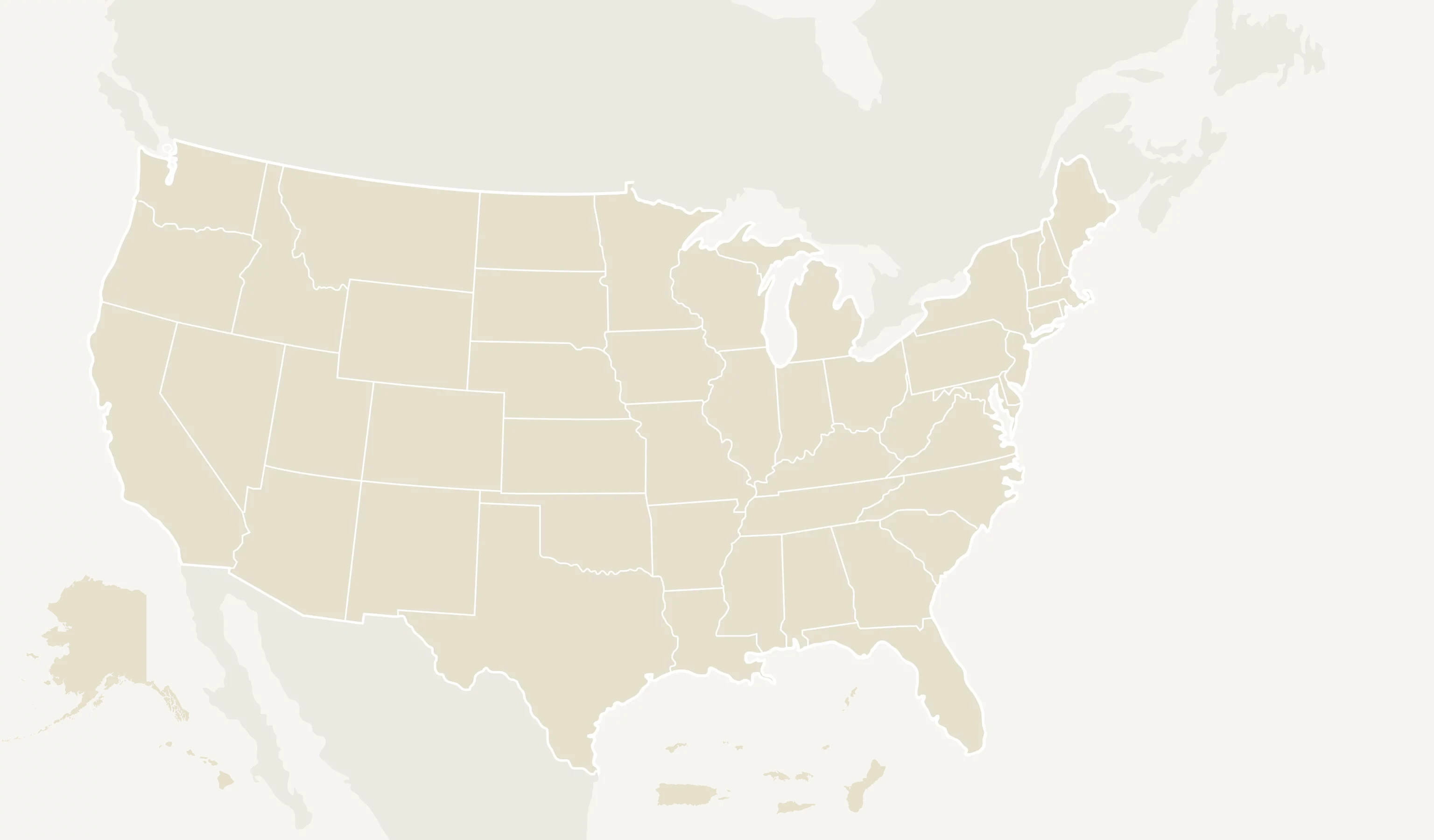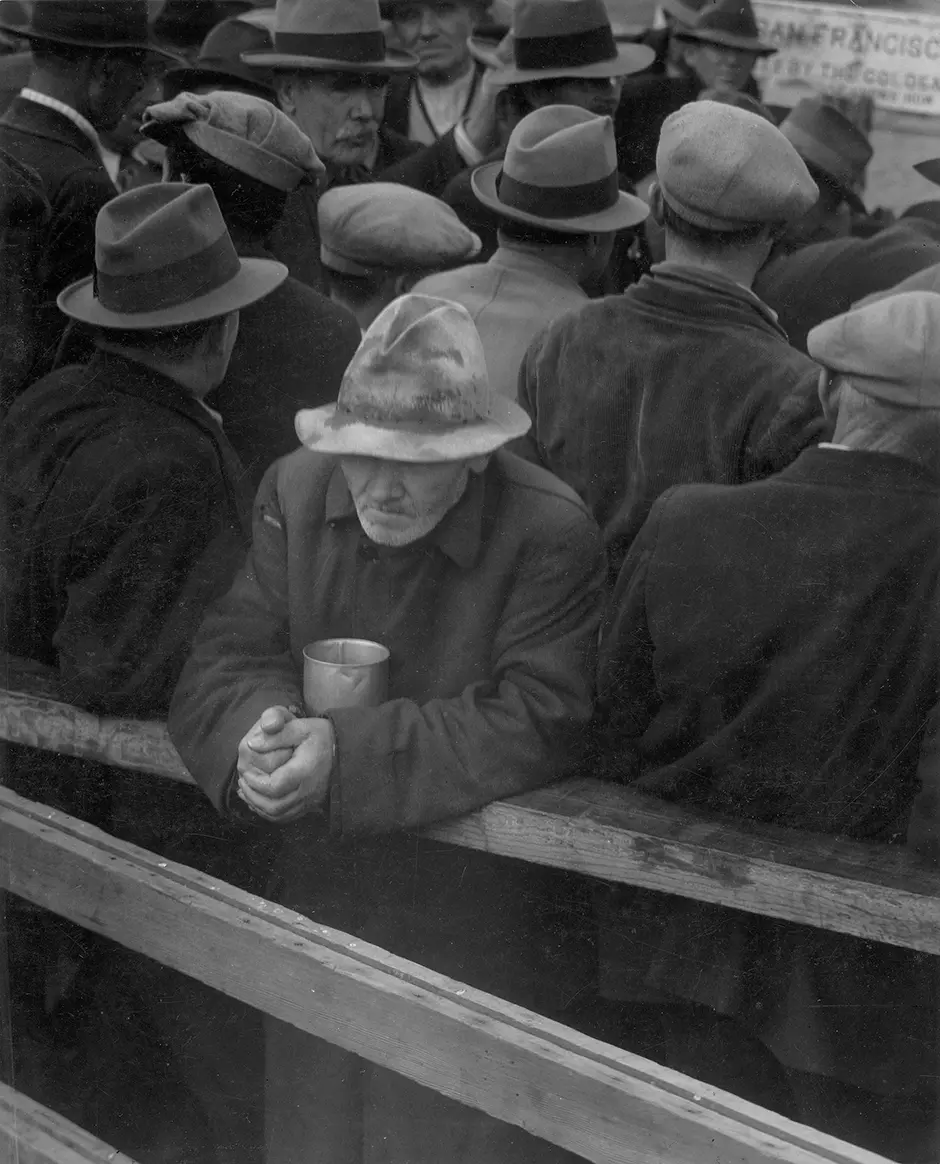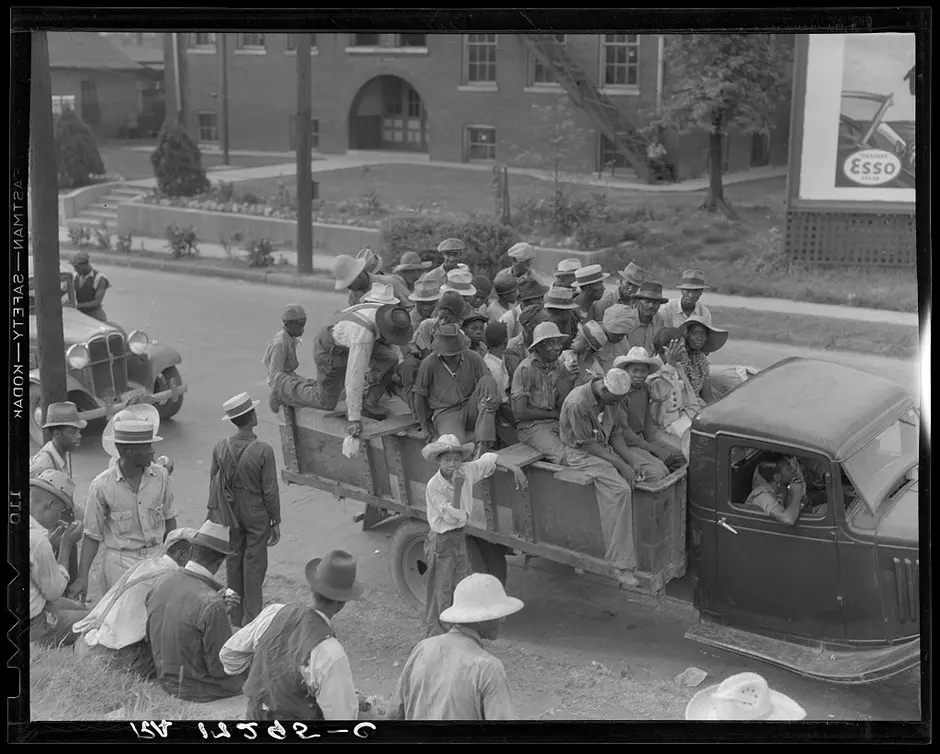
Dorothea Lange:
Documenting the Great
Depression
Beginnings

Dorothea Lange moved to San Francisco in 1918, where she started her career as a portrait photographer, drawing a mostly elite clientele. After the collapse of the stock market, her business declined. She left her studio to photograph the devastating impacts of the Depression. Her photographs caught the eye of Paul Taylor, an agricultural economist at the University of California, Berkeley, who hired Lange to work for the California State Emergency Relief Administration in 1935 and later encouraged colleagues in the Farm Security Administration to do the same. Lange soon married Taylor, beginning their years-long partnership.
Lange’s first assignment was for the California State Emergency Relief Administration, investigating the conditions of migrant farmers. Farm work in California had long relied on migrant labor, but Lange found the fields populated by an increasing number of “Dust Bowl refugees” — displaced tenant farmers and smallholders from the plains desperately seeking work out west. She documented the appalling conditions of these families, not only by taking intimate portraits, but also by adding captions that described their experiences. Lange’s most famous work is representative of this period, known today as “Migrant Mother.”
While Lange’s annotations often reflected long conversations with her subjects, her caption for “Migrant Mother” was a gross misrepresentation. The woman in the photograph, Florence Owens Thompson, later revealed that her family were not recent migrants. They had lived in the state for years and were simply passing through Nipomo when their car broke down. Although she became the quintessential “Okie,” Thompson was not an Oklahoma refugee of the Dust Bowl but rather a member of the Cherokee Nation whose husband was in town with their older children at the time buying car parts.
Davis, Lennard J. “Migrant Mother: Dorothea Lange and the Truth of Photography,” Los Angeles Review of Books, March 4, 2020.
“Migrant Mother” was often in the newspaper, alongside a series about the pea pickers’ camp. The image and related articles helped rally concern for conditions in the camp, prompting the State Relief agency to send vital food assistance. But Florence Owens Thompson’s family did not benefit from that aid, nor did they feel appropriately compensated. Thompson wrote to Lange, asking that she remove the image from circulation. “Migrant Mother” serves as a reminder to consider the social relations between photographers and their subjects, the limits of photography as advocacy, and the ethical stakes of documenting poverty and hunger.
Davis, Lennard J. “Migrant Mother: Dorothea Lange and the Truth of Photography, Los Angeles Review of Books, March 4, 2020.
This photo and its caption demonstrate Lange’s ethnographic process. The photograph appears to have been taken impromptu rather than staged as a formal portrait, as the mother looks away towards her other child rather than at the camera. But clearly, Lange spent time with this family discussing their experiences. The details also suggest the message Lange wanted to convey to policy-makers — that this family ended up in this situation through no fault of their own, and they were worthy of help and support, even when they didn’t want to ask.
While many of Lange’s photos depicted moments of misery and hardship, others captured more familiar scenes of domestic family life. Her photographs of families displaced by the Dust Bowl were often taken at meal times, revealing how the families cooked and ate on the road. Here, she even caught glimpses of the communal value that family meals could bring in spite of harsh surroundings.
The bulk of Lange’s work in California focused on documenting agricultural labor. Her photographs aimed to illuminate not only the day-to-day realities faced by farmworkers but also the economic and racial systems in which those workers operated and the inequities those systems reinforced. Lange took nearly 200 photographs of the production of California’s crops, including some photos of workers picking cotton and peas, pulling carrots, and cutting lettuce and cabbage. Images like this provided new portraits of the migrant laborers, including those of Mexican, Japanese, and Filipino descent, who made California’s agricultural economy possible.
Gordon, Linda. “Dorothea Lange: The Photographer as Agricultural Sociologist,” Journal of American History, 93, 3 (Dec. 2006): 706.
While Lange often hid the faces of agricultural workers in her photographs, others offered glimpses of children and older individuals to challenge popular impressions of who did farm work. These photographs reveal the intergenerational dynamics of farm communities. But unlike her other portraits, Lange’s photos of migrant farm workers did not include extensive captions, suggesting that she did not have long conversations with those families.
In 1936, Lange and Taylor traveled to the southern Great Plains to observe the displacement crisis of the Dust Bowl at its source. While highly critical of the ecological devastation wrought by over-farming and poor land-stewardship practices, Taylor was equally concerned by the large-scale commercial farms replacing smaller, family-owned ones and, in particular, by the plight of the tenant farmers who worked them. In Oklahoma and North Texas, Lange’s photographs captured both the parched, abandoned fields and the poverty and hardship that resulted, offering intimate portraits of farm communities impacted by the Dust Bowl.
When photographing farm families displaced from the plains, Lange seemed particularly interested in pointing to the hardships that predated the Dust Bowl. In Texas, she highlighted the experiences of tenant farmers in particular, who had long been mistreated by landowners. While often subtle in their critique, images like this highlight both the urgent material needs of farm families and the deeper inequities endemic in the American agricultural system.
Between 1936 and 1939, Lange and Taylor traveled extensively throughout the Jim Crow South, confronting a type of poverty and racial stratification that they — like many Americans — had never seen before. While Lange did not document specific acts of racial violence, her photographs and notes captured the subtle ways that white supremacy manifested in social and economic relations in rural communities, the endurance of plantation capitalism, and the deep racial hierarchies that structured day-to-day life.
Lange sought to document and expose all aspects of the racial caste system of the Jim Crow South. So, too, did she capture more quiet moments of interracial intimacy and camaraderie. Compared to other regions where she documented the impacts of farm mechanization and industrialization, her photographs in the South often showcased a world untouched by modern life and haunted by its past.
Labor Exploitation in the Jim Crow South

Lange’s primary interest in the South was in documenting the economic relations that both shaped and were shaped by the Jim Crow system. Her photographs captured every aspect of the southern agricultural economy, describing in detail the hiring systems, crop liens and debt servitude system, and abysmal wages through which white planters exploited Black workers. Her work focused on three primary crops — cotton, tobacco, and turpentine — recording every step in the process from start to finish, revealing them not simply as commodities but as products of human labor that were largely hidden from view.
Lange’s photographs in the South focused on housing and the appalling racial inequities. As with her photographs of Asian and Mexican farmworkers in California, her depictions of Black farmers included intergenerational families to demonstrate their deep ties to the land. Her portraits of Black family homes — always taken on the exterior of their dwellings — aimed not simply to showcase the conditions in which they lived but also to lift up their dignity, pride, and resilience, positioning them as equally deserving of full and equal rights for a white audience.
Over the course of their work together, Lange and Taylor became strong advocates for housing assistance and other relief programs that improved the lives of agricultural workers and their families. Most often, their appeals for federal intervention were implicit, expressed in the ways that Lange staged and framed her photographs. Still, in some cases, she made them more explicit in both the composition of her photographs and in her captions.
As a strong believer in the need for government intervention and support for struggling farmworkers, Lange sought to document how relief programs were (and were not) reaching those in need. Many of her photographs featured those seeking aid in rural areas, showcasing both the scale of the need and how the government implemented assistance programs in small towns.
Lange sought not only to document government assistance programs but also how farm communities organized to support one another through crisis — including mutual aid efforts, cooperative ventures, and community organizing. Of particular interest was the Southern Tenant Farmers Union, a first-of-its-kind interracial organization that helped sharecroppers and tenant farmers hit hard by the Depression. Union members worked together to fight evictions, demanding a more equitable share of the profits their labor produced. In addition to photographing union members, Lange tried to capture the vicious harassment and violence they faced.
After many years on the road with the U.S. government’s Farm Security Administration (FSA), Lange was awarded the prestigious Guggenheim Fellowship in 1941. But shortly after the attack on Pearl Harbor, she gave up the fellowship to take an assignment with the War Relocation Authority to document the forceful evacuation and internment of Japanese Americans. Lange’s photographs of the evacuation captured the hardships and painful experiences of evacuated families, illuminating the contradictory meanings of American citizenship and belonging during World War II.
Lange’s most intimate portraits from her work with the War Relocation Authority (WRA) were those of families, particularly women and children. Here, too, she aimed to capture both hardship and resilience, framing her subjects in ways that evoked empathy and, perhaps, stirred collective action. But unlike her previous works, her photographs documenting internment were not made publicly available as the WRA impounded them until after the war. Their impact instead came later, providing a poignant archive of a shameful chapter in American history.
Lange continued to work as a photographer after the war, teaching, publishing, traveling, and holding exhibitions. Her photographs often explored how California was growing and changing in the post-war years, capturing new construction and veterans re-adjusting to civilian life. She died in 1965, years before many of her photographs were ever publicly displayed.
The ethnographic import and historical context illuminated in Lange’s work are significant. The many migrant mothers she captured in her photographs in the 1930’s provide a unique and indelible portrait of American life that continues to inform how we understand the Depression to this day.
Lange spent significant time with her subjects, earning their trust, learning about them, and staging the scene. But when her works were displayed, these captions were sometimes left out, contributing to the common perception that her work reflected her “natural” eye or “feminine intuition” for capturing intimate emotions. Biographer Linda Gordon suggests such gendered assumptions belie the thoughtfulness and expertise Lange brought to her work: “far from being passively receptive, she was an assertive visual intellectual, […] working systematically to develop a photography that could be maximally communicative and revealing.”
Gordon, Linda. “Dorothea Lange: The Photographer as Agricultural Sociologist,” Journal of American History, 93, 3 (Dec. 2006): 696-727. See also Lennard J. Davis, “Migrant Mother: Dorothea Lange and the Truth of Photography,” Los Angeles Review of Books, March 4, 2020.
Documenting the Great
Depression
Established in 1935, the U.S. government’s Resettlement Agency was tasked with improving the lives of poor farmers, particularly those displaced by drought and the Dust Bowl. The agency’s “Information Division” documented the plight of farm families to promote the agency’s work.
With the goal of “introducing America to Americans,” the Agency’s photographers — including Dorothea Lange — offered intimate portraits of the everyday lives of millions of Americans struggling to survive the Depression. Lange’s photography fundamentally changed how Americans imagined poverty and hunger. Along with her husband Paul Taylor, she traveled across the country documenting rural communities. While taken in a journalistic, documentary style, Lange’s photos were intentionally composed to raise concern among political leaders and urbanites about the plight of farm families, the injustices of the agricultural political economy, and the racial exploitation upon which it was based.
Citations:
Dorothea Lange interviewed by Peter Odergard in The Closer for Me, Part II, WNET Public Broadcasting, 1965. Linda Gordon, “Dorothea Lange: The Photographer as Agricultural Sociologist,” Journal of American History, 93, 3 (Dec. 2006): 696-727. See also Lennard J. Davis, “Migrant Mother: Dorothea Lange and the Truth of Photography,” Los Angeles Review of Books, March 4, 2020.
Dorothea Lange helped create a “visual encyclopedia” of the Depression that fundamentally changed how Americans imagined hunger. Explore the map to discover how Lange documented the plight of rural communities across the country.
Museum Map
WISHING
TREE